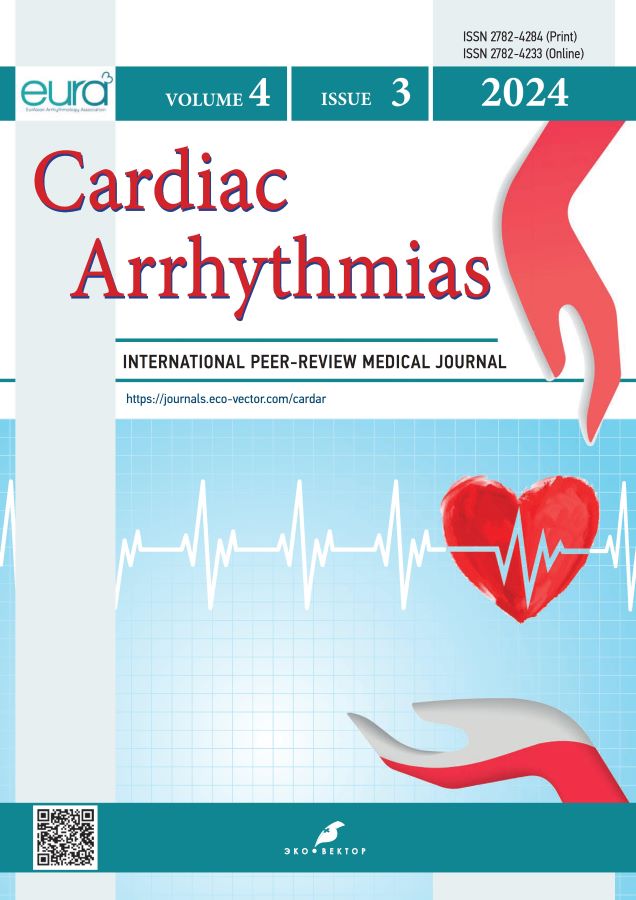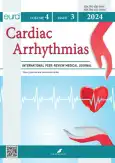Cardiac Arrhythmias
“Cardiac Arrhythmias” is an international peer-reviewed journal published under the auspices of the Eurasian Arrhythmological Association (EURA)
The goal of the journal is to unite the efforts of arrhythmologists, cardiologists, cardiovascular surgeons and scientists of other specialties to improve the quality of medical care for patients with cardiac arrhythmias and conduction disorders. It is done through wide discussion of the results of scientific, practical, experimental, and fundamental works devoted to the issues of clinical arrhythmology, electrophysiology of the heart and related disciplines.
The journal publishes clinical guidelines, original articles, article reviews, clinical cases, lectures / reports, discussions on current medical problems associated with heart rhythm and conduction disorders, as well as notes on the activities of the Eurasian Arrhythmological Association.
All translations of articles are carried out by the publisher and are free for the authors of the publication.
Publications
- quarterly, 4 issues per year
- continuously in Online First (Ahead of Print)
- free of charge for authors (no APC)
- in English, Russian and Chineese (full-text translation)
Distribution
- Open Access, under the Creative Commons Attribution-NonCommercial-NoDerivatives 4.0 International License (CC BY-NC-ND 4.0)
Current Issue
Vol 4, No 3 (2024)
- Year: 2024
- Articles: 4
- URL: https://journals.eco-vector.com/cardar/issue/view/12860
- DOI: https://doi.org/10.17816/cardar.43
Reviews
2024 ESC Guidelines for the management of atrial fibrillation developed in collaboration with the European Association for Cardio-Thoracic Surgery (EACTS): what is new?
Abstract
The article presents key approaches to the diagnosis and treatment of atrial fibrillation in light of the new 2024 ESC Guidelines for the management of atrial fibrillation developed in collaboration with the European Association for Cardio-Thoracic Surgery. The main changes made to the new recommendations are reflected. The innovative patient-oriented principle of atrial fibrillation treatment — AF-CARE is considered in detail. An analysis of the updated scale for assessing the risk of stroke and systemic embolism CHA2DS2-VA is given. The article provides definitions of clinical, subclinical, trigger-induced, newly diagnosed, paroxysmal, persistent and permanent forms of atrial fibrillation, algorithms for the treatment of different forms of atrial fibrillation based on the choice of drug therapy taking into account the left ventricular ejection fraction. Much attention is paid to screening and early detection of atrial fibrillation. The categories of patients for whom screening is advisable are determined. The importance of early diagnostics of atrial cardiomyopathy using atrial myocardial strain analysis is emphasized. The role of timely, guideline-based treatment of comorbid pathology such as chronic heart failure, diabetes mellitus, obesity, obstructive sleep apnea, arterial hypertension and others is emphasized in order to prevent atrial fibrillation and, if it occurs, to reduce relapses.
 5-14
5-14


Original Research
Radiofrequency ablation of the pulmonary vein ostia in elderly patients with atrial fibrillation
Abstract
BACKGROUND: Restoration and maintenance of sinus rhythm is one of the most important aspects of managing patients with atrial fibrillation. The greatest effectiveness is achieved when this intervention is performed in young patients without comorbidities and in patients with paroxysmal atrial fibrillation. The appropriateness of performing radiofrequency ablation of the pulmonary vein ostia in elderly patients with atrial fibrillation remains a subject of debate.
AIM: to study the immediate and long-term results of catheter ablation in elderly patients with AF.
MATERIALS AND METHODS: The study group consisted of 88 patients aged 75–88 years who underwent RFA of the pulmonary vein ostia. The technique used was classical, with femoral puncture access, and irrigated ablation catheter. Data analyzed included ECG parameters, incidence of systemic thromboembolic complications, functional class of chronic heart failure according to NYHA, subjective state post-procedure, occurrence of atrial fibrillation recurrences, and the impact of baseline clinical factors on disease recurrence.
RESULTS: In 80 patients (90.9%), atrial fibrillation did not recur during their hospital stay after radiofrequency ablation of the pulmonary vein ostia. In the long term (min 1.5, max 3.1 years), a cross-sectional observational study was conducted on 37 patients. Adherence to oral anticoagulants was 97.6%. No systemic thromboembolic events were recorded among the patients available for contact. Atrial fibrillation recurrences troubled 67.6% of patients after radiofrequency ablation. The main predictors of atrial fibrillation recurrence in elderly patients were the presence of hypertension (p=0.03) and baseline left atrial enlargement (p=0.001). Despite the high recurrence rate, there was a significant reduction in the functional class of chronic heart failure following radiofrequency ablation of the pulmonary vein ostia (p=0.009).
CONCLUSIONS: Strict selection is required for performing catheter ablation in patients with atrial fibrillation older than 75 years. Significant left atrial enlargement and uncontrolled hypertension are major limitations for performing RFA of the pulmonary vein ostia in the elderly. The procedure demonstrates significant effectiveness in terms of reducing chronic heart failure functional class in patients over 75 years old, despite the high recurrence rates in the long term.
 15-24
15-24


Case reports
Arrhythmic phenotypes of cardiac laminopathies: a case series
Abstract
This article conveys clinical cases of patients with cardiac laminopathy caused by mutations in the LMNA gene, the early manifestations of which were supraventricular, ventricular tachyarrhythmias and conduction disorders in the absence of myocardial structural changes. Moreover, it is shown the evolution of rhythm and conduction disturbances during the follow-up period, as well as the tendency of mutation carriers in the LMNA gene to develop life-threatening ventricular tachyarrhythmias and conduction disorders with a high risk of sudden cardiac death. Furthermore, herein are provided key recommendations of European and American experts regarding the concept of distinguishing laminopathies for mandatory molecular genetic testing, since carriers of LMNA mutations are associated with a poor prognosis. The data obtained confirm the importance of conducting a molecular genetic study using high-throughput sequencing of genes associated with hereditary rhythm disorders, including the LMNA gene, in the presence of clinical manifestations such as syncope, conduction disorders (atrioventricular block, sinus node dysfunction), supraventricular and ventricular tachyarrhythmias in combination with a family history, notably in the absence of structural heart diseases. Timely molecular genetic testing may facilitate the appropriate treatment including a cardioverter-defibrillator implantation.
 25-34
25-34


Implantation of a permanent left bundle branch pacing lead in a child after tetralogy of fallot repair. A case study
Abstract
Conduction system pacing, including His bundle and left bundle branch pacing, is an increasingly utilized strategy in adult patients with bradyarrhythmias and atrioventricular conduction disorders. This technique helps prevent the development of heart failure caused by electrical and mechanical dyssynchrony associated with chronic ventricular pacing. These outcomes support the feasibiliy of this technique in younger pediatric patients under comparable clinical conditions. A distinct category includes children who have undergone congenital heart defect correction and require permanent cardiac pacing. These patients are at higher risk of developing pacing-induced сardiomyopathy due to non-physiologic ventricular contraction, while options for prevention and management remain limited. Biventricular pacing is technically challenging in pediatric patients, and algorithms for minimizing ventricular pacing cannot be applied in the presence of complete atrioventricular block. We report a case of left bundle branch pacing in a child with a history of surgical repair of tetralogy of Fallot and implantation of a permanent pacemaker for postoperative complete atrioventricular block.
 35-39
35-39













